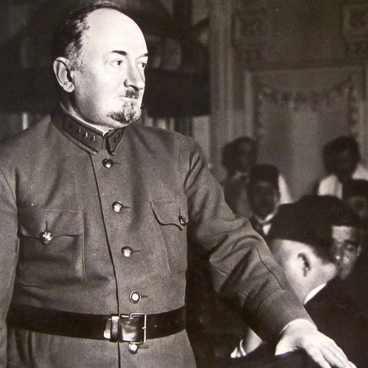Sofia Chicherina was born in 1867 in Paris. According to the noble tradition, at first the girl studied at home. The only daughter of Zhorzhina and Vasily Chicherin showed special talents in playing the zither and the piano, writing scripts for family theater performances and learning foreign languages. The child excellently spoke French, Italian, German and English.
According to the recollections of relatives, even in her youth, Sofia Chicherina was calm and tactful. Usually it was the sister who resolved conflicts and judged disputes between brothers. In addition, at the age of 13, she discovered a passion for pedagogy and began teaching peasant children in a school that her parents had built and maintained.
On the photo presented as part of the exhibition about the fate of Georgy Chicherin, you can see him with his brother and sister, as well as their mother. Presumably, the photograph was taken at the end of the 19th century in a photo studio in the city of Tambov. This version is supported by the woman’s mourning clothes. The husband and father of the family died in 1882.
It is worth saying that the relationship between relatives remained warm and trusting throughout their lives. In the 1906 correspondence between Sofia and Georgy Chicherin, when the latter lived in exile, one could find respect for revolutionary activity, and an understanding of popular discontent, and bold statements about the cruelty of repression in Russia.
In 1904, Sofia Chicherina visited about 30 settlements in the Vyatka, Kazan, Siberian and Ufa provinces to help create schools for the peoples of the Volga region. In her work, she was guided by the system of Nikolai Ilminsky, an orientalist and missionary. The main idea of his method was that students first had to master their native languages, and only then Russian - as an introduction to world culture.
Enthusiasm for educational activities did not go unnoticed among her contemporaries. Already in 1906, Sofia Chicherina was elected a member of the Russian Geographical Society.
In addition to the practical implementation of her ideas, from 1905 to 1910, the woman managed to publish several scientific articles and books on the state of education and the preservation of dialects among the eastern residents of Russia. For example, the volume “At the Volga Foreigners. Travel Notes.”
According to the recollections of relatives, even in her youth, Sofia Chicherina was calm and tactful. Usually it was the sister who resolved conflicts and judged disputes between brothers. In addition, at the age of 13, she discovered a passion for pedagogy and began teaching peasant children in a school that her parents had built and maintained.
On the photo presented as part of the exhibition about the fate of Georgy Chicherin, you can see him with his brother and sister, as well as their mother. Presumably, the photograph was taken at the end of the 19th century in a photo studio in the city of Tambov. This version is supported by the woman’s mourning clothes. The husband and father of the family died in 1882.
It is worth saying that the relationship between relatives remained warm and trusting throughout their lives. In the 1906 correspondence between Sofia and Georgy Chicherin, when the latter lived in exile, one could find respect for revolutionary activity, and an understanding of popular discontent, and bold statements about the cruelty of repression in Russia.
In 1904, Sofia Chicherina visited about 30 settlements in the Vyatka, Kazan, Siberian and Ufa provinces to help create schools for the peoples of the Volga region. In her work, she was guided by the system of Nikolai Ilminsky, an orientalist and missionary. The main idea of his method was that students first had to master their native languages, and only then Russian - as an introduction to world culture.
Enthusiasm for educational activities did not go unnoticed among her contemporaries. Already in 1906, Sofia Chicherina was elected a member of the Russian Geographical Society.
In addition to the practical implementation of her ideas, from 1905 to 1910, the woman managed to publish several scientific articles and books on the state of education and the preservation of dialects among the eastern residents of Russia. For example, the volume “At the Volga Foreigners. Travel Notes.”



